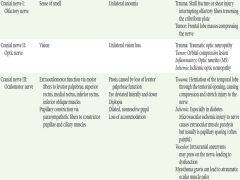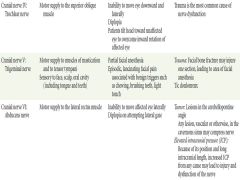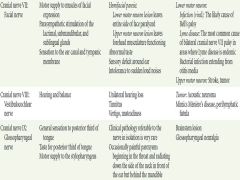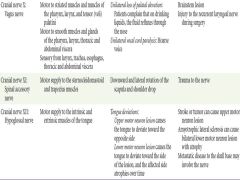![]()
![]()
![]()
Use LEFT and RIGHT arrow keys to navigate between flashcards;
Use UP and DOWN arrow keys to flip the card;
H to show hint;
A reads text to speech;
14 Cards in this Set
- Front
- Back
|
Whom to suspect trigeminal neuralgia |
Patients with normal findings on the head and neck examination and no neurologic deficits who have episodic, unilateral facial pain associated with nonpainful triggers |
|
|
Bell's Palsy |
Idiopathic facial nerve parlaysis
Though to be to zoster reactivation
Lower motor neuron pattern |
|
|
Ramsay-Hunt syndrome |
unilateral facial paralysis, a herpetiform vesicular eruption, and vestibulocochlear dysfunction |
|
|
Bilateral facial nerve paralsysi |
Lyme disease
Also consider infectious mononucleosis |
|
|
Whom to suspect a neoplastic cause for facial nerve paralysis |
recurrent ipsilateral facial paralysis significant pain prolonged symptoms any other concomitant cranial nerve abnormality |
|
|
Central facial paralysis |
Forehead sparing |
|
|
Asymmetrical sensorineural hearing loss |
Consider vestibular shcwannoma |
|
|
Multiple sclerosis |
Demyelination of axons within the CNS
recurring episodes of neurologic symptoms that rapidly evolve during days and slowly resolve
areas of specific CNS impairment: cognition; cranial nerves; motor pathways, sensory pathways; cerebellar pathways; and bowel, bladder, and sexual dysfunction |
|
|
Uhthoff’s phenomenon |
temporary worsening of current or preexisting signs or symptoms of MS secondary to small increases in the patient’s body temperature |
|
|
Lumbar puncture findings in MS |
Pleocytosis Elevated CSF IgG Oligoconal bads on CSF electrophoresis |
|
|
CN 1 -3 |

|
|
|
CN 4 - 6 |

|
|
|
CN 7 - 9 |

|
|
|
CN 10 - 12 |

|

